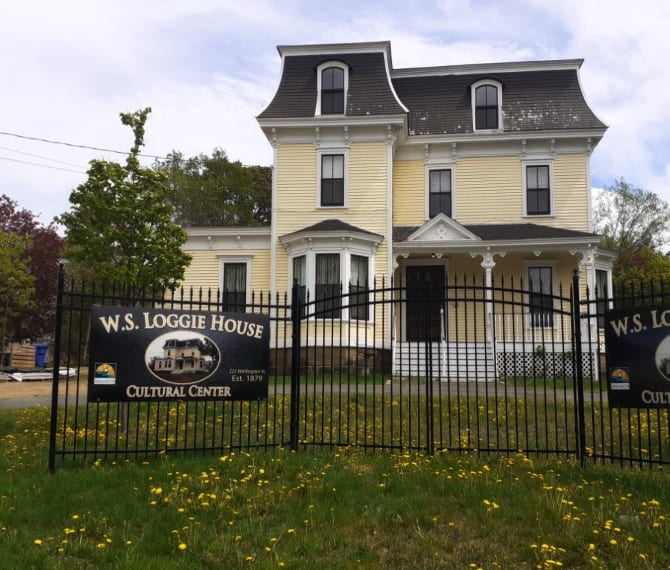Loggie House: A Landmark and a Legacy
By Charlotte Loggie, Miramichi Historical Society

In 1879, a Victorian home exuding grace and elegance was under construction in the town of Chatham, New Brunswick. The builder was George Cassady, and the man who was to own this lovely house and raise his family here was William Stewart Loggie, or W.S. Loggie (1850-1944) as he was more commonly known.
After leaving school at age 14, Loggie began work with the MacDougall and Snowball Company in Chatham which sold dry goods. Loggie took this business over and added fish packing and exporting, as well as manufacturing and exporting lumber and pulpwood. He was an ambitious young man and needed a house that reflected this ambition and success.
The house built for him was called “Hillside” as it sits on a slope overlooking Wellington Street. The house is built in typical Second Empire style with gothic entrances, bay windows, and a mansard roof like that on Beaverbrook House. Inside are oak floors with inlaid parquetry, slate fireplaces, and a commanding portrait of Francis Peabody, the founder of Chatham. The portrait was painted in 1837 by Albert G. Hoit of Boston, and restored by Elizabeth Houcks of Sussex, NB.
W.S. Loggie married Elspeth Kerr and they raised twelve children in this house. One of W.S. and Elspeth’s sons, Leigh, took over the family business after his older brother Kerr died, and Leigh lived alone in the house with a housekeeper, until his death in 1977. Bev (Jarvis) Campbell recalls playing at the house with the housekeeper’s daughter and seeing the two horses that Leigh kept: Sisko and Queenie.
Lois Martin was the driving force behind the restoration of Loggie House. As a member of Chatham Town Council, she had pressed for the purchase of the house and its preservation as an historic landmark. By 1979 negotiations were complete, and with the help of various grants from organizations and foundations such as a Canada Works grant, the Sadiye Bronfman Foundation, and the Beaverbrook Foundation, the house became the property of the Town of Chatham, and a board was formed to oversee the use of the house and its ongoing presence in the community. The house opened to the public in the fall of 1980 as the Loggie Cultural Centre. In addition to providing a meeting space, the house hosted events such as travelling art exhibits, craft lessons and in the summer, guided tours.
In 1982, in recognition of her role in restoring the W.S. Loggie House in Chatham and other heritage projects, Lois was awarded a medal for Community Service in Atlantic Canada from the Heritage Canada Foundation. In 1985, she was named “Miramichi Lady of the Year” by the Tau Chapter of Beta Sigma Phi. Her dedication to this house was intense. When approached by students from Dr. Losier Middle School in 2012 to be part of their “Walking Tour of Historic Chatham” project, she responded eagerly, and at the age of 83, made a recording of her description of Loggie House, and attended the launch of the students’ project at the Chatham Public Library.
Currently, the Loggie House Board of Directors is chaired by Mrs. Joan Cripps, who has held this position for 32 years. Under her leadership the house continues to hire summer students to provide guided tours and is open at other times of the year for special exhibits and fundraisers. The Miramichi Senior Sawdust Makers, a non-profit group of woodworking enthusiasts, make their home in the carriage house of Loggie House. The interior of the house is beautifully decorated, with exquisite period furniture and artifacts. Due to the current pandemic restrictions, the house may have to wait for another season for visitors.
As Lois Martin so fittingly said, “A visit to the W.S. Loggie House is a visit back through time”.
Giv’er Miramichi is about “What’s up, what’s new, what’s happening”. We are focused on building people up, supporting one another and celebrating our successes.



Rae Loggie, sister of Kerr and Leigh lived in the house until her death. She looked after her brothers. I remember that she drove a 1930,s coupe that she called Bessie. It was considered a relic in the 1950’s but it was kept in great shape . When Kerr died, Leigh moved home from BC and took over the business. The two were so alike that it was often joked that Leigh even wore Kerr’s suits.